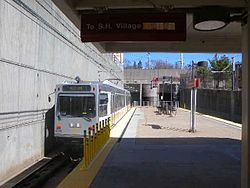- Mt. Lebanon Tunnel
-
Mt. Lebanon Tunnel 
South end Overview Line 42 South Hills Village Location Allegheny County, Pennsylvania Status operational System Pittsburgh Light Rail Start Dormont Junction (PAT station) End Mt. Lebanon (PAT station) No. of stations 0 Operation Owner Port Authority of Allegheny County Operator Port Authority of Allegheny County Technical Construction New Austrian Tunnelling method Length 3,000 feet (910 m) No. of tracks 2 Gauge 5 ft 2 1⁄2 in (1,588 mm) Electrified overhead catenary Not to be confused with Mt. Washington Transit Tunnel, another tunnel of the Pittsburgh Light Rail system.The Mt. Lebanon Tunnel is a light rail tunnel in Allegheny County, Pennsylvania, also known as the Dormont/Mt. Lebanon Transit Tunnel, part of the Pittsburgh Light Rail system.
The 3,000 feet (910 m) tunnel connects the Dormont Junction and Mt. Lebanon Stations beneath Washington Road & West Liberty Ave. from Shady Drive East to McFarland Road at a maximum depth of 100 feet (30 m), and runs beneath a cemetery.
The pre-tunnel trolley street line, which ended in 1984, ran from the long-removed Clearview Loop stop on Alfred St. (Mt. Lebanon) to the intersection of McFarland Rd. and Raleigh Ave. (Dormont).
The tunnel was constructed by a technique called the New Austrian Tunnelling method, a tunneling process developed thirty years ago that has become the primary tunneling practice in Europe. This is the first time that this money-saving technique was used for transit construction in the United States.[1]
The difference with NATM lies in the means of support required to maintain the rock cavity and the configuration of the tunnel structure. With conventional tunneling, support of the rock cavity consists of a rib cage framework of steel beams and horizontal wooden planks A reinforced steel concrete lining is added to create a perfectly shaped tunnel. With NATM, the rock surrounding the hole becomes the support system. This is done by lining the tunnel cavity with several thin layers of shotcrete, concrete that is blown on under air pressure. [2]
The tunnel has continuous television surveillance.[3]
References
- ^ Ozdemir, Levent (17-22 April). North American tunneling: proceedings of the North American Conference Tunneling Conference 2004. CRC Press. p. 473. ISBN 9058096696, 9789058096692.
- ^ "Mt. Lebanon Tunnel: What Went Wrong". Tunnels & Tunnelling 21 ((4)): 61–62. April 1989.
- ^ Joe Grata (10 July 2005). "Getting Around: In Pittsburgh's mini-subway, eyes are always watching". Pittsburgh Post Gazette. http://www.postgazette.com/pg/05191/535238-147.stm. Retrieved 1 March 2009.
External links
- 40°22′59″N 80°02′36″W / 40.38293°N 80.04322°W - Southern portal
- 40°23′25″N 80°02′29″W / 40.39035°N 80.04146°W - Northern portal
Categories:- Pittsburgh, Pennsylvania stubs
- Transportation in Pittsburgh, Pennsylvania
- Tunnels in Pennsylvania
Wikimedia Foundation. 2010.
